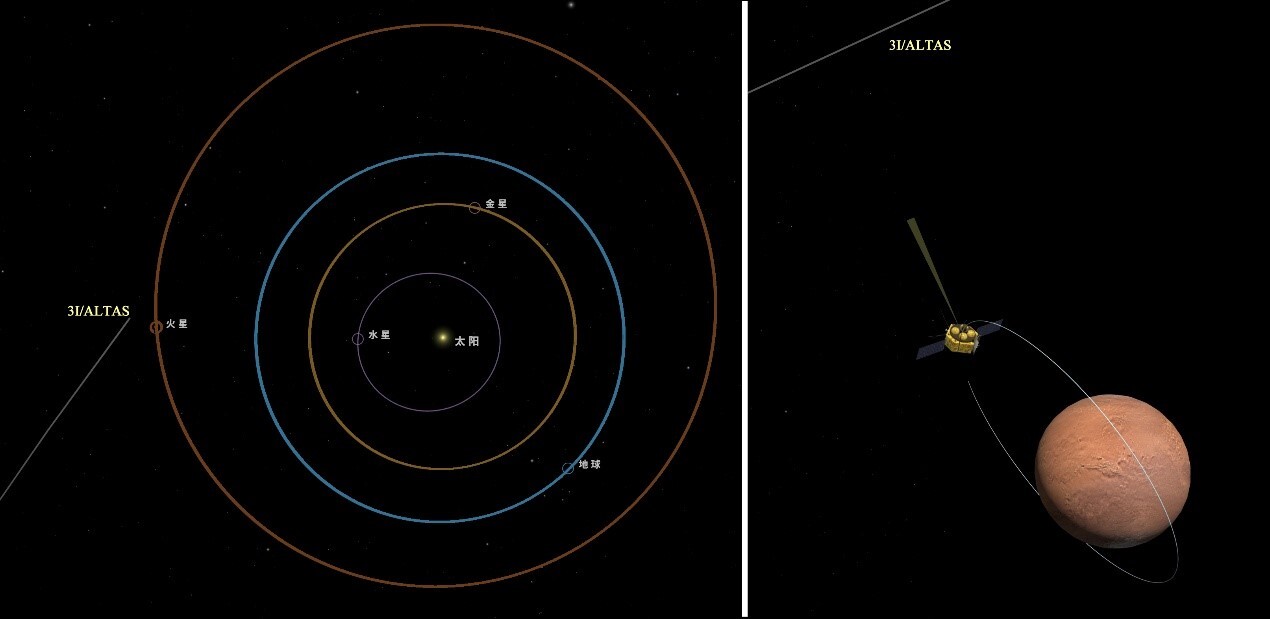 An illustration of the relative positions between the Tianwen-1 probe's orbiter and the interstellar object 3I/ATLAS. Illustration: CNSA
An illustration of the relative positions between the Tianwen-1 probe's orbiter and the interstellar object 3I/ATLAS. Illustration: CNSA
China's Tianwen-1 Mars probe's orbiter has used its high-resolution camera to successfully observe the interstellar object 3I/ATLAS. During the observation, the Tianwen-1 orbiter was approximately 30 million kilometers away from the target, making it one of the closest detectors to have observed this object to date, the Global Times learned from the China National Space Administration (CNSA) on Thursday.
After the data captured by the high-resolution camera was received and processed by the ground application system, the images clearly revealed the comet-like features of the object, consisting of a cometary nucleus and its surrounding coma, with a diameter reaching several thousand kilometers, per the statement the CNSA provided to the Global Times on Thursday.
Researchers created an animation using a series of images taken over 30 consecutive seconds, vividly demonstrating the object's trajectory. Based on these observational data, scientists are conducting further in-depth studies on 3I/ATLAS, said the CNSA.
 The image of the interstellar object 3I/ATLAS captured by the high-resolution camera onboard the Tianwen-1 probe's orbiter. Photo: Courtesy of the CNSA
The image of the interstellar object 3I/ATLAS captured by the high-resolution camera onboard the Tianwen-1 probe's orbiter. Photo: Courtesy of the CNSA
The successful observation of 3I/ATLAS marks a significant extended mission for Tianwen-1, read the CNSA statement. By utilizing the probe to observe faint celestial objects, it conducted technical tests for the asteroid exploration mission of Tianwen-2, accumulating valuable experience.
3I/ATLAS was discovered on July 1, 2025, by a sky-survey telescope located in Chile. It is the third known interstellar object to visit the solar system, traveling through it along a hyperbolic trajectory.
This object may have formed around ancient stars near the center of the Milky Way, with an estimated age of approximately 3 to 11 billion years - potentially older than the solar system itself. It serves as a rare sample for studying the composition, evolution, and early stellar history of exoplanets, holding significant scientific value, according to the CNSA.
The Tianwen-1 team began preparing for the Atlas observation in early September, the CNSA revealed.
The object's extreme distance (about 30 million kilometers), high motion speed (about 58 kilometers per second), even faster relative velocity to the Tianwen-1 orbiter, which is about 86 kilometers per second, and its small size (cometary nucleus diameter of approximately 5.6 km), as well as the fact that the object appeared extremely faint when observed from Mars orbit, making imaging extraordinarily challenging. This placed stringent demands on the orbiter's attitude pointing control and imaging strategy.
The optical payload aboard the Tianwen-1 orbiter was originally designed to image the bright Martian surface. This was the first attempt to capture such a distant and relatively dim target (10,000 to 100,000 times fainter than typical Martian surface targets).
This mission pushed the high-resolution camera's capabilities to the limit for such faint target's detection, said the CNSA.
The Tianwen-1 probe entered Mars orbit in February 2021 and has been operating stably for 4 years and 8 months, remaining in good condition.
















